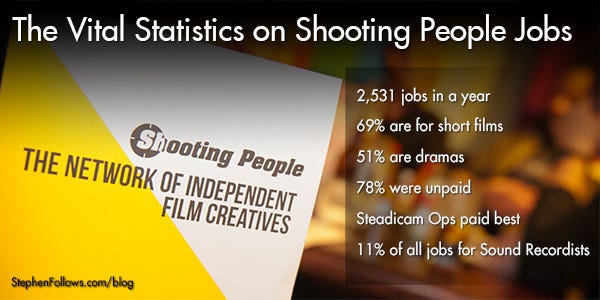How many jobs are in Shooting People's Filmmaker bulletin?

This week I took a look at independent filmmaking in the UK, to see what films are being made and what connections filmmakers are looking to form. To do this, I analysed a year's worth of jobs on the community site Shooting People. I have been a member for over a decade and have used them many times to find cast, crew and collaborators. For those who don't know, Shooting People is a daily email which serves as a bulletin board, news provider and soapbox for filmmakers. It costs £40 a year to subscribe and any member (known as a 'Shooter') can post to the bulletins.
I took a year's worth of their flagship 'Filmmaker' bulletin (1st December 2012 to 30 November 2013 inclusive) and analysed the jobs advertised. In summary:
In a year, Shooting People sent out 350 copies of its Filmmaker bulletins, containing 2,531 jobs.
Shooting People offered 550 paid jobs over the 12 months
69% of the jobs were on short films and 21% were feature film projects
78% of the jobs were unpaid
The most sought-after roles were Sound Recordist, Producer and Director of Photography
11% of all jobs posted were looking for a Sound Recordist
The roles that offered the highest average daily rate were Steadicam operator (£213), Visual Effects Editor (£200) and Director (£172)
All of the jobs for Set Designers, 3rd ADs and Clapper Loaders were unpaid
A third of the productions were insured
Wednesday is the busiest day for jobs
What films are Shooters making?
The industry average for UK feature films is 20% Drama, whereas 51% of Shooting People films are Dramas. Two thirds are short films
Most Popular Roles Sought
There were jobs advertised for 203 different roles, although when I cleaned up the data I was left with 169 unique roles. 'Cleaning' involved fixing spelling mistakes and conflating entries for extremely similar roles, such as Cinematographer and Director of Photography.
Which roles are most often paid?
Shooting People allows both paid and unpaid jobs to be advertised in its bulletins and overall, 22% of jobs were paid and 78% were unpaid. When we split this by the type of film being made we discover that 87% of jobs on short films are unpaid whereas 69% of feature film roles are unpaid.
Below is a summary of what percentage of jobs advertised on Shooting People were paid (I only included roles which had at least 10 jobs posted over the 12 month period). I'm surprised to see roles such as Gaffer and Spark so low on the list, but then again this chart illustrates the jobs offered, not jobs accepted. As a producer myself I know how hard it can be to find a good gaffer on low rates.
How much is being offered?
Of those that were paid, 54% were calculated on a daily rate, 16% offered a fixed fee, 4% were on hourly rates, 13% were weekly rates, 3% monthly, 2% annual and 8% simply stated that the job paid at least the National Minimum Wage.
Below is a chart of the average rate for paid jobs which was calculated on a daily basis. I suspect that the top two roles are expected to include equipment, meaning that a 'daily fee' is not as high as it at first seems.
When are most jobs posted?
Over the 12 month period, there were 350 bulletins (i.e. every single weekday without fail and most weekends). Within those emails were 2,531 jobs posted by 760 different people, with Wednesday being the busiest days for jobs.
A few thoughts
As I said in my introduction, I'm a supporter of what Shooting People stands for. At its best Shooting People allows filmmakers to share, learn, grow, connect and get work, and all for a low annual cost. Over the years I have heard lots of grumbling about the percentage of jobs which are not paid and the low rates of the ones which are. I don't think my research will do much to quell this chorus but I think it's worth noting that:
The content of the Shooting People bulletins is a reflection of the industry. Any ire at the lack of paid work is better directed to filmmakers generally than to Shooting People as an organisation.
Shooting people is more a platform for up-and-coming filmmakers than for working film professionals. There are plenty of very experienced filmmakers on the site but, as this data shows, they are heavily outnumbered by those early in their filmmaking careers.
To put the jobs offered on Shooting People into perspective, here are some sobering statistics:
Over 12 months shooting People offered 2,531 jobs on its Filmmaker bulletin, of which 550 were paid.
In 2012 there were 5,530 students studying film
In 2012 46,246 people were in paid employment for film and video production
Epilogue
I won't regard this issue as properly addressed until I have performed the same analysis on the rest of the Shooting People bulletins, including the Documentary and Screenwriters lists. So watch this space.
I am indebted to a few people who helped me fill in the blanks on my Shooting People bulletin collection. These heroes include Andy Woodling, Phil Peel, Gary Thomas, Roxy Holman and Thabo Mhlatshwa. Also, thank you to Michelle and Sue who helped along the way.



